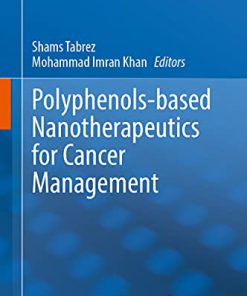Endometrial Cancer Risk Factors Management and Prognosis 1st Edition by PhD 9781536138887 1536138886
$50.00 Original price was: $50.00.$25.00Current price is: $25.00.
Endometrial Cancer Risk Factors Management and Prognosis 1st Edition Ph.D. Ferrero – Ebook Instant Download/Delivery ISBN(s): 9781536138887, 1536138886

Product details:
- ISBN 10:1536138886
- ISBN 13:9781536138887
- Author: PhD
Endometrial Cancer: Risk Factors, Management and Prognosis
Table contents:
Chapter 1
Epidemiology and Risk Factors
Abstract
1. Epidemiology
2. Type I and II Endometrial Cancer
2.1. Endometrioid Adenocarcinoma
2.2. Serous Papillary Adenocarcinoma
2.3. Clear Cell Adenocarcinoma
2.4. Undifferentiated Carcinoma
3. Risk Factors
3.1. Older Age
3.2. Overweight and Obesity
3.3. Metabolic Syndrome
3.4. Wrong Dietary Habits
3.5. Gynecological Diseases
3.6. Type 2 Diabetes Mellitus
3.7. Ethnic Group
3.8. Family History of EC
3.9. Menstrual and Reproductive Factors
3.10. Genetic Factors
3.10.1. MMR System Alterations (Not Syndrome-Related)
3.10.2. Lynch Syndrome (or Hereditary Non-Polyposis Colorectal Cancer or HNPCC
3.10.3. Cowden Syndrome (CS) and Cowden Syndrome Like (CSL)
3.10.4. HBOC (Hereditary Breast and Ovarian Cancer) Syndrome
3.10.5. RAD51 G135C Polymorphism
4. Protective Factors
References
Chapter 2
Molecular Pathology of Endometrial Carcinoma and Its Histopathological Correlations: Beyond a Dualis
Abstract
1. Introduction
2. Molecular Classification of Endometrial Carcinoma
3. Molecular Biology of Endometrial Carcinoma
3.1. Estrogen Receptors
3.2. Progesterone Receptors
3.3. PTEN
3.4. PIK3CA
3.5. β Catenin
3.6. E Cadherin
3.7. B-Cell Lymphoma 2
3.8. Cyclin D1
3.9. K-RAS
3.10. P53
3.11. P16
3.12. HER 2/NEU
3.13. Ki67
3.14. IMP3
3.15. ARID1A
3.16. C-MYC
3.17. Angiogenic Factors
3.18. FGFR2
3.19. HGF and CMET
3.20. Microsatellite Instability
4. Correlations between Major Histological Types and Molecular Pattern
5. Progression Pathways
5.1. Endometrioid Carcinoma
5.2. Non-Endometrioid Carcinoma (NEC)
6. Genomic Classification
6.1. Class 1: Ultra Mutated POLE
6.2. Class 2: Microsatellite Instability
6.3. Class 3: Endometrioid Tumors with Low Copy Number
6.4. Class 4: Tumors “Serous Like” with High Number of Copies
References
Chapter 3
Histopathological Classification
Abstract
1. Introduction
2. Endometrioid Adenocarcinomas
2.1. Variants of Endometrioid Histotype
2.1.1. Villoglandular Carcinoma
2.1.2. Secretory Carcinoma
2.1.3. Ciliated Carcinoma
2.1.4. Endometrioid Carcinoma with Squamous Differentiation
2.1.5. Mucinous Carcinoma
3. Non-Endometrioid Carcinomas
3.1. Serous Carcinoma
3.2. Clear Cell Carcinoma
4. Undifferentiated and Dedifferentiated Endometrial Carcinomas
4.1. Mixed Carcinoma
4.2. Carcinosarcoma MMMT (Malignant Mϋllerian Mixed Tumor)
4.3. Squamous Carcinoma
References
Chapter 4
Clinical Presentation and Transvaginal Ultrasound Assessment
Abstract
1. Introduction
2. The Role of Transvaginal Ultrasound
Conclusion
References
Chapter 5
Radiological Assessment
Abstract
1. The Role of Radiology in Endometrial Cancer Evaluation
2. Computed Tomography
3. Direct and Contrast-Enhanced Magnetic Resonance Imaging
3.1. Diffusion Weighted MRI (DWI-MRI)
3.2. Perfusion
3.3. BOLD-MRI
3.4. 3T MRI
3.5. MRI in Staging Endometrial Cancer
3.5.1. Stage I
3.5.2. Stage II
3.5.3. Stage III
3.5.4. Stage IV
4. PET-CT
Conclusion
References
Chapter 6
Surgical Management of Early Stage Endometrial Cancer
Abstract
1. Introduction
2. Endometrial Cancer in Young Women: Surgical Treatment Options
3. Guidelines for Treating Endometrial Cancer Patients with International Federation of Gynecology a
4. Total Abdominal Hysterectomy with Bilateral Salpingo-Oophorectomy (TAH-BSO)
5. Vaginal Hysterectomy (VH)
6. Laparoscopic Assisted Vaginal Hysterectomy (LAVH) and Total Laparoscopic Hysterectomy (TLH)
7. Laparoscopic Treatment
8. Robot-Assisted Treatment
9. Comparison between Laparoscopy and Robotic-Assisted Surgery
10. The Role of Lymphadenectomy in Surgery for Early Stage Endometrial Cancer
11. Clinical Recommendation Guidelines for Endometrial Cancer in FIGO Stage II
12. Sentinel Node (SN) Detection in Early Stage Endometrial Cancer
13. Complications of Surgical Treatments for Early Stage of Endometrial Cancer
13.1. Lymphocele
13.2. Urinary Tract Injuries
14. Obesity and Endometrial Cancer
15. Controversies in the Management of Early Stage Endometrial Cancer
Conclusion
References
Chapter 7
A Newer Perspective in the Surgical Approach to Endometrial Cancer: Sentinel Lymph Node Evaluation
Abstract
1. Introduction
2. Sentinel Lymph Node Detection
2.1. Tracer Injection Site
2.1.1. Uterine Corpus (Subserosal Myometrium)
2.1.2. Cervical Site
2.1.3. Endometrium
2.2. Lymphatic Mapping Method
2.2.1. Radio Nuclear Method
2.2.2. Colorimetric Methods
2.2.3. Near-Infrared Method
2.2.4. Combined Method
3. Anatomopathologic Alanalysis of SLNs
3.1. Clinical Implications of Low Volume Metastases
4. The Importance of Applying SLN Mapping Algorithm
Conclusion
References
Chapter 8
Adjuvant Therapy for High-Risk Endometrial Cancer
Abstract
1. Introduction
2. Low Risk Endometrial Cancer
2.1. Stage IA, Endometrioid G1-2 with LVSI Negative
3. Low-Intermediate Risk Endometrial Cancer
3.1. Stage IB, Endometrioid G1-2 with LVSI Negative
4. Intermediate-High Risk Endometrial Cancer
4.1. Stage IA Endometrioid G3 with LVSI Negative/Positive or Stage IA- IB Endometrioid G1-2 with LVS
4.1.1. Lymphadenectomy Performed with Negative Lymph Nodes
4.1.2. Lymphadenectomy Not Performed
5. High Risk Endometrial Cancer
5.1. Stage IB Endometrioid G3 with LVSI Positive/Negative, or Stage II-III, or Other Histologies at
5.2. Stage I Endometrioid IB G3 with LVSI Positive/Negative
5.2.1. Lymphadenectomy Performed with Negative Lymph Nodes
5.2.2. Lymphadenectomy Not Performed
5.3. Stage II Endometrioid
5.3.1. Lymphadenectomy Performed with Negative Lymph Nodes
5.3.2. Lymphadenectomy Not Performed
5.4. Stage III Endometrioid
5.5. Other Histologies
5.5.1. Serous Carcinoma and Clear Cells
5.5.2. Carcinosarcomas and Undifferentiated Tumors
5.6. Molecular Classification
References
Chapter 9
Management of Advanced Endometrial Cancer
Abstract
1. Introduction
2. Systemic Therapy
2.1. Hormonal Therapy
2.2. Chemotherapy
2.2.1. First Line Chemotherapy
2.2.2. Second Line Chemotherapy
2.2.3. Prognostic and Predictive Markers to Chemotherapy
2.3. New Biological Agents
3. Local Therapy
3.1. Surgery
3.2. Radiotherapy
References
Chapter 10
The Role of Radiotherapy
Abstract
1. Introduction
2. The ESMO – ESGO – ESTRO Distribution of Risk Classes in Endometrial Cancer [1]
3. Role of Adjuvant Radiotherapy and Brachytherapy
3.1. ESMO – ESGO – ESTRO Consensus
3.1.1. Low Risk Endometrial Cancer (IA G1-G2, LVSI Negative)
3.1.2. Intermediate-Risk Endometrial Cancer (FIGO IB G1-G2, LVSI negative) High-Intermediate Risk En
3.1.3. High Risk Endometrial Cancer (FIGO IB, Grade 3, Regardless of LVSI Status; Stage II- Stage II
3.1.4. High Risk Non Endometrioid Cancers
3.2. NCCN Guidelines (Updated to 2018)
4. Role of Exclusive Radiation Therapy
References
Chapter 11
Endometrial Cancer in Elderly Patients
Abstract
1. Introduction
2. Endometrial Cancer in the Elderly Patient
3. Geriatric Assessment
Conclusion
References
Chapter 12
New Perspectives with Targeted Drugs
Abstract
1. Introduction
2. PI3K/AKT/MTOR Inhibitors
3. EGFR and HER2 Inhibitors
4. Angiogenetic Inhibitors
5. Poly (ADP-Ribose) Polymerase Inhibitors
6. Immunotherapy
Conclusion
References
Appendix I
Conservative Treatments for Endometrial Cancer
Abstract
Introduction
Conclusion
References
Appendix II
Brachytherapy Technique in Endometrial Cancer
Abstract
Introduction
Conclusion
References
Figures
Tables
Appendix III
Role of Palliative Radiation Therapy in Endometrial Cancer
Abstract
Introduction
References
About the Editor
Index
Blank Page
Read Less
People also search:
endometrial cancer risk factors
type 2 endometrial cancer risk factors
endometrial cancer risk factors acog
endometrial cancer risk factors mnemonic
endometrial cancer risk factors cks
You may also like…
Business & Economics - Management & Leadership
Business & Economics - Management & Leadership
Uncategorized
Medicine - Oncology
Business & Economics
Business & Economics - Management & Leadership












